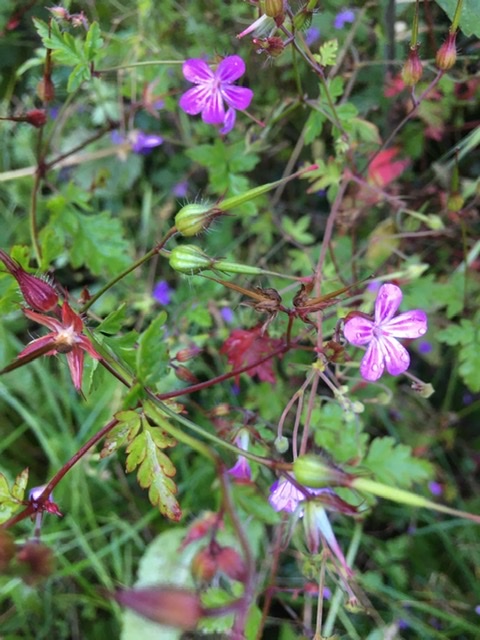When we bought our property last winter, the owner had always religiously trimmed the weeds and grasses on the property to make it look nice for sale. Then spring came and Covid 19 happened and we couldn’t visit the property for more than 2 months. So when we finally were able to go back, after a particularly warm and dry spring, the weeds that were normally trimmed almost to ground level had now grown almost to armpit lengths.
The fact that the plants had been able to grow unhindered by cutting was already very educational, because it showed much more clearly where the soil had retained a lot of water and where it hadn’t. The height of the plants also showed me where the soil condition was richer and where the poor soil (or total lack thereof) stunted the growth of the plants.
For example, my clay slope where I planted my orchard seems to have retained a lot of moisture, and despite it having been the driest spring in 40 years, all of my trees (except one) and the abundant growth of weeds were totally fine. Although I expected the slope to have issues with water runoff, due to the very thick vegetation growing on it, whatever rain there was, managed to seep into the soil and stay there.
Now because our property has many different microclimates due to it being two sides of a valley with several springs and a creek running through it, and variously oriented dry stone walls. Basically I have learned that despite some pieces of land being really close to each other, the microclimates and soil conditions appear to be vastly different even just 5 meters apart.
I have noticed there are a few different areas that have significantly different vegetation growing naturally on it. I’ve marked them on the map by circling them with different colours. Here’s what I’ve noticed on the different plots. I’m still a novice when it comes to weed-reading so I would love your help with this!
Starting with the blue encircled plot:
This plot is steeply sloped and gets sun in spring/summer morning to midday. It is generally a humid part. The ground is made up out of lots of big rocks that do absorb the sun’s heat in the morning generously, releasing it slowly over the day. We have wild strawberries spread out al over the property, but nowhere near as abundantly as here. It is basically one big carpet of wild strawberries, and they taste amazingly sweet and are much bigger then the ones I usually find in the forest. I believe this plot has been one of the least disturbed plots on our property in terms of soil being overturned or compacted. Before the strawberries ripened there were a lot of dandelions in this spot as well. I don’t intend to change much to this plot because these strawberries are awesome and the slope is too steep to use it for much else anyway. I only intend to create pathways to get to the strawberries easier.
Then there are the two purple spots.
They are equal in the sense that both get relatively few sun because they are shades by trees and walls, and they are very moist because of two little springs running through them. These spots are almost exclusively overrun by stinging nettles. I believe I read that stinging nettles like to grow on wet and rich soils. I can imagine the soil near the springs being particularly rich in minerals because the springs deposit a lot of silt. I intend to keep one patch of nettles for cooking, but hope to use the soil on the other patch to grow other shade and wetloving edible plants. Suggestions are welcome!
That brings me to the yellow plot.
This is without a doubt the most barren of plots we have. Although it is the only piece of flat land we which would have been the ideal spot to grow our vegetables, it is unfortunately also the worst spot in terms of the soil, or better to say an almost total lack thereof. It is going to be part of a long process to transform this plot into something fertile, which I have talked about
Here. Now with the vegetation growing unhindered it was nice to see what actually does grow on little more that bare rocks. What I’ve spotted so far is three varieties of wild geraniums on the sunniest parts of the plot. Tall grasses closest to the water edge of the creek. Some clover and some narrowleaf plantain, and then some leafy plant that I haven’t identified yet but is basically covering the whole area. Any idea what this tells me about the soil?
Finally the red plot, which is where we’ve planted our fruit trees and is a clay slope.
This plot takes the most sun, and also has the most diverse vegetation growing on it.
Basically there is an undergrowth of wild strawberries and a lot of ground elder, then a diversity of wildflowers (buttercups, dandelion (mainly on the lower parts of the slope) blue bugle, forget-me-not,...) some stinging nettles but it’s not taking over the place, lungwort is growing abundantly as well, some small patches of tall grasses, some wild grapes, and then saplings of cornel, elderberry, maple, and paradise trees. Some mosses in the shady parts. While there seems to be more diversity in plants, the plants in the sunniest part of the slope where we planted our fruit trees didn’t grow very tall. This plot will be our main production plot in the first years, so I’m really interested in understanding the soil here better.Anything you could devise from my explanation and my pictures is very welcome!
Feel free to scour my pictures to see if there’s any noteworthy ‘weed’ growing that I haven’t spotted yet!

 5
5










 2
2






 3
3




 2
2




 2
2




 3
3




 2
2





